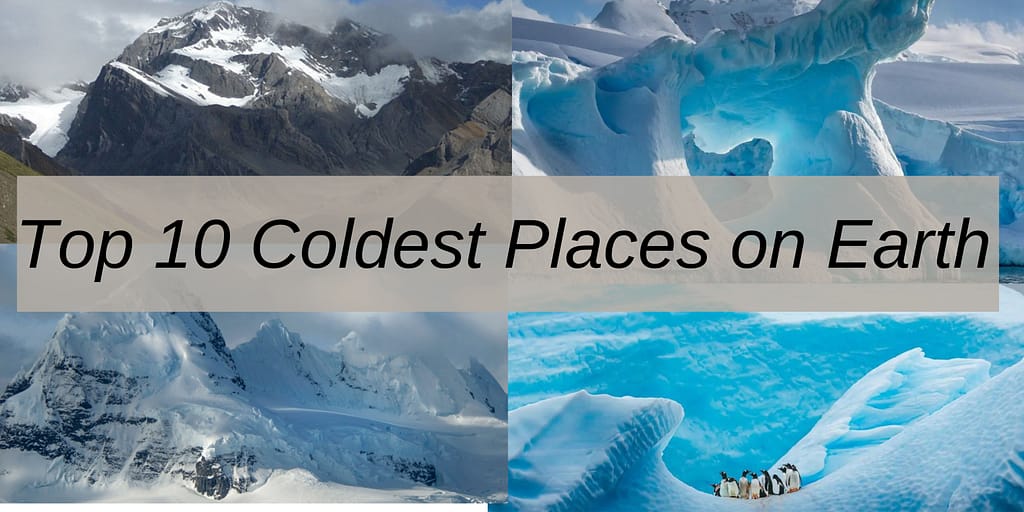Introduction
The Earth is a planet of extremes, and nowhere is this more evident than in the coldest places. This article delves into the top 10 coldest places on Earth, exploring their unique climates, geographical locations, and what makes them so inhospitable. These regions, primarily located in high latitudes and altitudes, endure some of the harshest and most frigid conditions imaginable.
1. Antarctica: East Antarctic Plateau

The East Antarctic Plateau holds the record for the coldest temperatures ever recorded on Earth. In August 2010, temperatures plummeted to a bone-chilling -128.6°F (-89.2°C). This vast, icy plateau is situated at a high elevation and is perpetually covered in ice and snow. The extreme cold is a result of its high altitude, clear skies, and the long polar night, which lasts for several months each year.
2. Antarctica: Vostok Station

Located at the heart of the East Antarctic Ice Sheet, Vostok Station is one of the coldest places inhabited by humans. The Soviet Union established this research station in 1957, and it recorded the world’s lowest temperature of -128.6°F (-89.2°C) on July 21, 1983. The station experiences some of the harshest conditions due to its altitude, latitude, and distance from the
coast, resulting in extremely low temperatures year-round.
3. Antarctica: Dome Fuji

Dome Fuji, also known as Dome F, is another high-altitude site in Antarctica known for its frigid temperatures. This ice dome reached a temperature of -128.6°F (-89.2°C) on July 21, 1983, rivaling Vostok Station. Dome Fuji is a key site for ice core drilling, providing valuable climate data that stretches back over hundreds of thousands of years. The clear, dry air and high elevation contribute to its extreme cold.
4. Greenland: Summit Station

Summit Station, located at the highest point on the Greenland Ice Sheet, is the coldest place in the Northern Hemisphere. It experiences extreme cold due to its high elevation (10,551 feet or 3,216 meters) and the fact that it is situated far from any moderating ocean influences. Winter temperatures at Summit can drop to -76°F (-60°C), and it remains below freezing even during the summer.
5. Canada: Eureka, Nunavut

Eureka, a weather station located on Ellesmere Island in Nunavut, Canada, is known for its extreme cold. It is one of the northernmost settlements in the world, experiencing long, dark winters and short, cool summers. Winter temperatures can plunge to -55°F (-48°C), and the area is characterized by its arid, icy desert landscape. Eureka is crucial for Arctic research and weather monitoring.
6. Russia: Verkhoyansk

Another contender for the coldest inhabited place, Verkhoyansk is also located in the Sakha Republic of Russia. It recorded a temperature of -89.8°F (-67.6°C) in February 1892. Verkhoyansk experiences significant temperature variations, with extremely cold winters and surprisingly warm summers. The town is known for its stark seasonal contrasts, making it one of the most thermally extreme places on Earth.
7. Russia: Oymyakon

Oymyakon, a rural locality in the Sakha Republic of Russia, is often cited as the coldest inhabited place on Earth. In 1933, Oymyakon recorded a temperature of -89.9°F (-67.7°C). The village is situated in a valley that traps cold air, resulting in incredibly low winter temperatures. Despite the harsh conditions, a small population endures the severe cold, adapting their daily lives to the extreme climate.
8. United States: Denali, Alaska

Denali, formerly known as Mount McKinley, is the highest peak in North America, standing at 20,310 feet (6,190 meters). The mountain experiences some of the coldest temperatures in the United States, particularly at its higher elevations. Winter temperatures can drop below -75°F (-60°C), and the combination of high altitude and harsh weather conditions makes Denali one of
the most challenging climbs in the world.
9. United States: Barrow, Alaska

Barrow, officially known as Utqiaġvik, is the northernmost city in the United States, located above the Arctic Circle. It experiences extreme cold, with winter temperatures often dropping below -30°F (-34°C). The city endures polar nights where the sun doesn’t rise for about 65 days during winter, contributing to its frigid temperatures. Barrow’s remote location and harsh climate make it a unique place to live and study Arctic conditions.
10. Norway: Svalbard

Svalbard is an archipelago located in the Arctic Ocean, north of mainland Norway. The region experiences long, cold winters and short, cool summers. Temperatures in winter can drop below -20°F (-29°C), and the area is known for its polar bears, glaciers, and rugged terrain. Svalbard is one of the northernmost inhabited places on Earth and is an important center for Arctic
research.
Climate and Adaptation

The extreme cold in these regions is primarily due to their high latitudes, altitudes, and in some cases, their continental interiors which are far from the moderating influence of oceans. These factors contribute to the low temperatures and harsh conditions that characterize the coldest places on Earth.
Despite the challenging environments, humans have found ways to adapt and live in some of these coldest regions. Inhabitants have developed specialized clothing, housing, and lifestyle adaptations to survive the extreme cold. For instance, in Siberia, traditional clothing made from reindeer hides provides insulation against the freezing temperatures. Similarly, in places like Greenland and Nunavut, the design of traditional igloos and modern insulated homes helps retain heat.
Impact on Flora and Fauna

The coldest places on Earth have unique ecosystems that are home to specially adapted flora and fauna. In Antarctica, for instance, life is limited to hardy microorganisms, lichens, and a few mosses. In the Arctic regions, polar bears, Arctic foxes, and a variety of marine life such as seals and whales thrive in the harsh conditions.
These extreme environments also play a crucial role in the global climate system. Antarctica and Greenland ice sheets, for example, act as massive reflectors of solar energy, helping regulate the Earth’s temperature. Additionally, they serve as vital indicators of climate change, with their melting rates providing important data on global warming trends.
Scientific Research

These regions’ extreme cold and unique conditions make them important sites for scientific research. Research stations in Antarctica, Greenland, and other cold regions provide critical data on glaciology, meteorology, and climate science. Studies conducted in these areas help scientists understand past climate patterns, predict future climate scenarios, and develop strategies to mitigate the impacts of climate change.
Conclusion
The Top 10 coldest places on Earth represent some of the most extreme environments known to humanity. From Antarctica’s icy expanses to Siberia and Greenland’s frozen landscapes, these regions challenge life with their severe cold and harsh conditions. Despite these challenges, play a crucial role in our understanding of the planet’s climate and ecosystems. As climate change continues to impact these fragile environments, the importance of studying and preserving these top 10 coldest places on earth becomes ever more critical.


